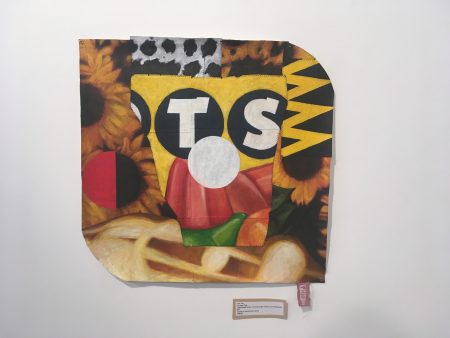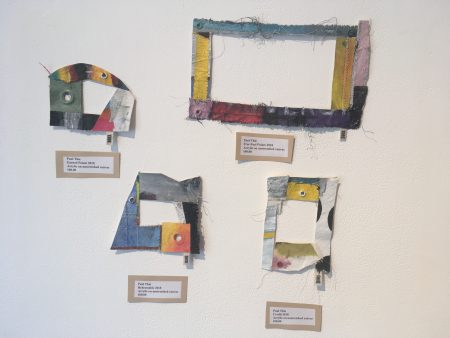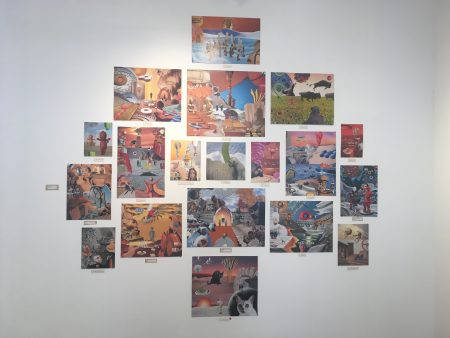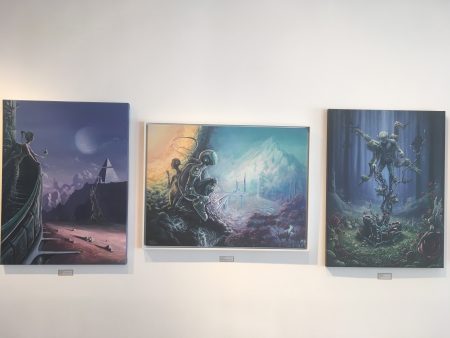Over the last year, Thunder-Sky, Inc. has been probing visual culture vis-à-vis consumers, products, and marketing, as this year’s theme has revolved around “Product Placement,” with the gallery presenting exhibitions that frame production and commerce. Certain shows over the last year at this gallery have been right on the mark regarding pop art aesthetics and consumer reappropriation. This seminal show – the titular Product Placement: A variety of Works – seeks to directly and disparately approach commercial pastiche in a mixed-media relay. Co-founders Keith Banner and Bill Ross, who have wrestled with the term “outsider art,” preferring ‘unconventional’ to describe the works (rather than the connotations of outsider art), present a divergent gulf from the polished, honed graphic art and commercial aesthetics of product design and pop art with Product Placement. The conventional postmodern techniques that often target commodity fetishism are sublimated with “neo-folk” (Schwartz) approaches. The show is most successful when it embraces discernible, brooding folk aesthetics, giving a fresh perspective to visual art that appropriates consumer culture – Paul Thie’s uneven stitching and hand-cut tapestries rattle unique relations between artist and materiality. Kevin Cascell manipulates operative collage and photomontage sequences in mixed-media commercial spectacle to echo magical realist scenarios. Conversely, other artists’ works readily evade the show’s theme – necessitating wavering and fallible understandings of “visual art as commodity” to theoretically approach the thesis at all.
In the exhibition flyer Thunder-Sky, Inc. readily admits that the show is teeming with aesthetic disparity, though the majority of the works are homogenously two-dimensional. John Humphries is the sole exception, whose high-fired raku clay sculptures adorn the gallery with arching, bowing, and spiraling ribbed towers. Reminiscent of apocalyptic dune skyscrapers, the works are uniformly – and appropriately – titled “Crinkle-Cut City” (2017). Certain pillars are gargantuan high-rise minarets while others are curtailed stubs in comparison. As Alan D. Pocaro noted in his October 2010 review of A Vanguard of Six at The Weston Gallery, Humphries has a penchant to “examine the built environment” with “touches on the experience of landscape,” evinced by this sculptural series. While the piece is effective in its architectural feats and corporeal affect, it makes little use of the theme of “product placement.” Certainly, by a stretch of the imagination we could assume Humphries’ qualitative investigation on the built environment mirrors the media-spearheaded exploit of “the power of place and an intuitive understanding of the structuration of space to facilitate consumption” (Goss 18) but this requires a great deal of justification. This same criticism can be extended to Humphries’ paintings.
Humphries’ watercolor works, including his “Cloud Constellation” series (2016) – which curiously weave aberrant materials including wood, thread, and wool with paint – and the planimetric “A Stone Monolith is Not Wisdom” (2018) demonstrate dexterously penned geometric watercolor studies. The structures are faint sketch-like reminders of synthetic cubism that meditate on earthly structures rather than synthesize the “product placement” ethos as Humphries’ watercolor works mediate the technicalities of drawing, explicating orthographic and axonmetric techniques to facilitate representations of shifting perspective. As Humphries wields education in Architecture and Fine Arts in Design, his analytic works offer interesting studies in mixed-media and perspective but seem considerably distant from the appropriative “product placement” keynote.
Kevin Cascell’s wall of découpage works feature a myriad of decorative prints paired with graphic imagery, desert backgrounds and other-worldly landscapes, including familiar religious iconography and theological structures. Curious characters litter “Off the Wall” (2018) and the “Montages” (2018) series, with neatly buried shadowy hermetic strokes, including memento mori skulls and divine fixtures. Cascell’s pasted paper cut-outs occupy various surfaces, containing three-dimensional elements and beacons of commodity culture and popular imagery: Tony the Tiger floats on a pedestal before a galactic arena where a dozen helicoptors float above a series of crossroads. Caskell transforms mixed-media build environments with fantastical prose, situating commodity culture within outlandish, puzzling and inviting narratives. Caskell’s photomontages are reminiscent of pop-art pioneer Sir Eduardo Luigi Paolozzi’s papiers collés, as Caskell equips Product Placement with challenging scrutiny.
Comparatively, Paul Thie utilizes montage for a personal and humanist approach. Thie examines psychological attitudes towards behavior in response to product placement, using innovative folk-art aesthetics to image the “consumer socialization framework to examine placement-related attitudes” (Gregorio and Sung 83). Thie makes use of systematic frameworks that investigate the origins of social factors to reveal the index of the artist’s hand, articulating materiality by weaving treated textiles into unison. The works are asymmetrical, craggy and asperous – all too human while the works consider fabrication and production.
Thie brashly uses specific and referential titles as a framing system, as in “Sex Cam” (2018). Here a series of acrylic prints are stacked along unstretched canvas – Bazooka Bubblegum advertisements are harnessed with rich gradients, images of fruit, and delicate character studies. Thie is able to wield disparity more triumphantly than some of his cohorts, as his works “Damnm” (2016) and “Free Fuel Points” (2018) use pop icons with folk aesthetics and empty negative space to figuratively and literally frame product placement.
Thie is perhaps the most successful in tackling the Product Placement ethos, by continuing Caskell’s appropriative practice but adding an art-brut touch to cull the index of the artist’s uneven touch. One segment of Product Placement is devoted to four works that employ Caskell’s stitching on loose, slanted canvas; raw hems of varied fabrics lead to loose strands and, as in “Redeemable” (2018), often times the stitching exceeds the plane of the canvas. “Earned Points” (2018) and “Credit” (2018) cheekily valorize marketing lexicon but the works are baggy, folksy, and asunder. Each work places irregular and tattered rectangles against the gallery wall, where the alabaster background seeps through negative space. Thie uses a framing tactic to implant Benjaminian “aura” in works that directly deal with materiality and production. Thie’s contributions are ambiguous enough to not circumscribe themselves to pointed referential yet they comply with and advance beyond the “product placement” theme.
Logan Walden’s works are the greatest outlier in “Product Placement.” As in his November 2017 show Portals, A Glimpse into Other Worlds at Covington’s Perennial Gallery, Walden is still considerably interested in painting a world of fantasy on canvas. Pieces such as “A Secret Place” (2018) carouse mythic terrace and garden space, where a frozen, dusk-enshrined ashen globin-creature stands on a tree, framed by blossoming roses. Walden’s pieces do not regard Product Placement’s themes – in material, ideation, or technical considerations – but rather seek to cull storytelling through painting, which resounds of stuffy self-regard, as each painting seems to posit its own motif and filmic narrative. Thus, Walden’s works are extremely pictorial and almost photorealistic, a jarring and uneasy juxtaposition with the folk art aesthetics and ideational values the other artists in Product Placement posit.
Walden’s works have technical value and his background in graphic design and large-budget films are evident (the artist has worked on major motion pictures like “Transformers 3” and reality television shows like “The Bachelor”). However, Walden also detracts from the show due to this surface-level obsession with glistening lore and wilderness creatures, as the fairyland inventions of space, reverie, and Atlantis are more decorative than they are theoretically challenging. A theme such as “product placement” inherently necessitates a bit of theory, which – as evidenced by Thie and Caskell – can be approached through multifaceted modes. Walden’s paintings immediately summon the aesthetics of “festival painting,” which is bolstered by the artist’s experience painting at music events such as Coachella, Boogaloo, and Burning Man – events that brim with fantasy-laden psychedelic work that are all too often surface-level and spectacle obsessed for the transient festival art audience. Consequently, while such work may be appropriative for concert venues, they are a blight upon the rest of Product Placement, both aesthetically and intellectually.
Product Placement is a mixed-media show with equally varied perspectives on framing production and commodity culture – at times vigorous and intriguing while sometimes altogether lost. Certain artists’ works, particularly when considered in unison with others, lead to intriguing consequences, as indicated by Paul Thie’s and Kevin Caskell’s use of photomontage and collage sequences. Although it is difficult to tie some works or artists to a rather rich and philosophically curious theme, the works that keenly and cleverly instrumentalize “product placement” are intriguing enough to allure and captivate audiences. Paul Thie’s inventive take on “product placement” is incentive alone to visit Thunder-Sky, Inc.’s Product Placement.
–Ekin Erkan
Works Cited
Goss, Jon. “The ‘Magic of the Mall’: An Analysis of Form, Function, and Meaning in the Contemporary Retail Built Environment.” Annals of the Association of American Geographers, vol. 83, no. 1, Mar. 1993, pp. 18–47., doi:10.1111/j.1467-8306.1993.tb01921.x.
Gregorio, Federico De, and Yongjun Sung. “Understanding Attitudes Toward and Behaviors in Response to Product Placement.” Journal of Advertising, vol. 39, no. 1, 4 Mar. 2013, pp. 83–96., doi:10.2753/joa0091-3367390106.
Pocaro, Alan D. “Garde Duty :: AEQAI.” AEQAI, 15 Oct. 2010, aeqai.com/main/2010/10/garde-duty/.
Schwartz, Kathy. “A ‘Superunknown’ Impulse Binds Neo-Folk Artists.” CityBeat Cincinnati, 13 Nov. 2013, www.citybeat.com/arts-culture/visual-arts/article/13006209/a-superunknown-impulse-binds-neofolk-artists.









